Airfix 1/72 GA.11 Hunter
|
KIT #: |
? |
|
PRICE: |
$ |
|
DECALS: |
Two options |
|
REVIEWER: |
Carmel
J. Attard |
|
NOTES: |
GA 11 conversion from Allmark |
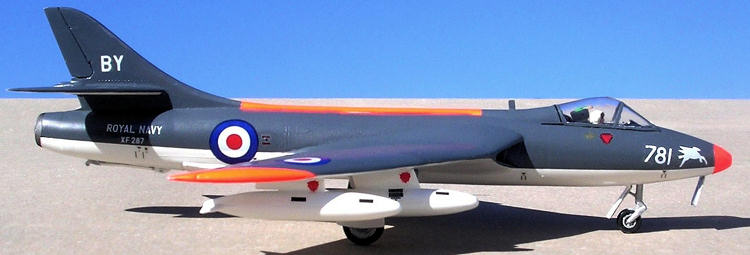
Following two years since the
prototype Hunter P1067 first flew, the
Avon
–powered Hunter F Mk1 made its first flight on
May 16th, 1953.
The type eventually equipped the first RAF Squadron No 43 in mid 1954. The F Mk1
had only a brief service and there were the Sapphire-powered F Mk2 and 5, which
also had a brief service life. The Mk1 was superseded by the F Mk4, which was
powered by
Avon
115, and carried more internal fuel and provision for underwing weapons or fuel
tanks. This mark saw service
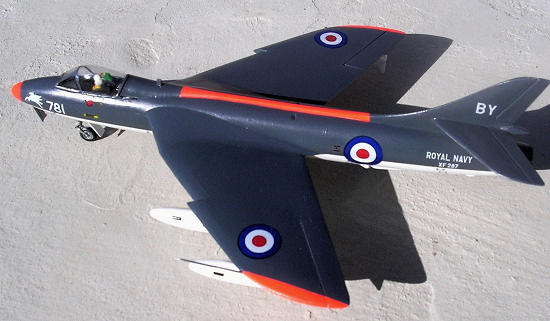 with
Denmark
(F Mk51) and (F Mk52). In due
course there were more Hunter marks and export versions. But it was the F Mk4
that the Royal Navy showed interest. The Hunter FGA 11 was a conversion of the
Mk4. The Fleet Air Arm of the Royal Navy acquired a number of ground attack
Hunters for use as advanced weapons trainers. These were conversions of early
Mk4s having modified leading edge extensions, a field arrestor hook and had the
guns deleted. A small number of FGA 11 were out fitted with cameras redesignated
as PR 11s.
with
Denmark
(F Mk51) and (F Mk52). In due
course there were more Hunter marks and export versions. But it was the F Mk4
that the Royal Navy showed interest. The Hunter FGA 11 was a conversion of the
Mk4. The Fleet Air Arm of the Royal Navy acquired a number of ground attack
Hunters for use as advanced weapons trainers. These were conversions of early
Mk4s having modified leading edge extensions, a field arrestor hook and had the
guns deleted. A small number of FGA 11 were out fitted with cameras redesignated
as PR 11s.
The first FGA 11
conversion flew during early 1962 and by the middle of the year the aircraft
were delivered to No 739 Squadron at Lossiemouth. No 738 and No 764 squadrons
also used the FGA 11 and 40 aircraft were delivered to the FAA. A follow on
order was planned but this was cancelled by budget cuts so a number of standard
Hunters F Mk4s operated for a short period. The FGA 11 continued to operate from
Yeovilton by civilian contract pilots to Airworks Services Limited as part of
the FRADU (Fleet Requirements and Air Direction Unit). The aircraft flew
alongside Hunters T Mk8s in support of naval training for both the FAA and
surface fleet operating in the role of “enemy” aircraft. On a number of
occasions during the mid 60s to 70s these were often spotting visiting Hal-Luqa
airfield,
Malta
to the good advantage of local aircraft spotters. The Hunter FGA 11 also formed
the aerobatic team at RNAS Brawdy, known as the f ‘Rough Diamonds’ used for
aerobatic displays, the lead aircraft being XF287: 781. The aircraft carried
standard camouflage except for the Pegasus badge on the nose. These were
transferred from Lossiemouth to Brawdy in 1964 and carried day glow orange band
on the nose, spine and wing tips.
This is a retooled Airfix kit into
an FGA9 version. Details about the kit issued by Airfix are already known
elsewhere and no point repeating it.
The two wing halves
were first cemented together. Filler is used to block the holes provided for the
wing stores after a backing thin plastic card was glued on the inside. Cockpit
area was detailed to improve the somewhat basic offering, the Martin Baker
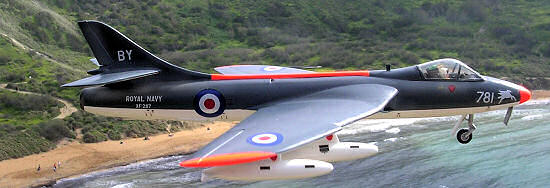 ejector
seat was reshaped, adding seat straps, ejection seat pull handles, control
column and a crew figure painted in the RAF style of costume. A blanking plate
in form of a rectangular plastic card piece was added to avoid the see through
effect across the intakes. Lead weight added to nose and the two fuselage halves
were joined together. Any over scale in thickness at the wing trailing edges was
scraped using one’s own judgement after close study to photos. The cockpit
canopy was not truly accurate and this I replaced with a clear and thinner one
which comes as spare with the Hunter Prototype Pavla set. The kit fuselage tail
pipe was also removed and this was replaced with a spare resin one that comes
also with the Pavla Hunter set referred to earlier. The ammunition link
collectors were removed and the canon ports faired over with filler. An arrestor
hook was added at the rear beneath the fuselage. This was centrally positioned
while a tail bumper was
added adjacent to the hook and to
starboard side.
ejector
seat was reshaped, adding seat straps, ejection seat pull handles, control
column and a crew figure painted in the RAF style of costume. A blanking plate
in form of a rectangular plastic card piece was added to avoid the see through
effect across the intakes. Lead weight added to nose and the two fuselage halves
were joined together. Any over scale in thickness at the wing trailing edges was
scraped using one’s own judgement after close study to photos. The cockpit
canopy was not truly accurate and this I replaced with a clear and thinner one
which comes as spare with the Hunter Prototype Pavla set. The kit fuselage tail
pipe was also removed and this was replaced with a spare resin one that comes
also with the Pavla Hunter set referred to earlier. The ammunition link
collectors were removed and the canon ports faired over with filler. An arrestor
hook was added at the rear beneath the fuselage. This was centrally positioned
while a tail bumper was
added adjacent to the hook and to
starboard side.
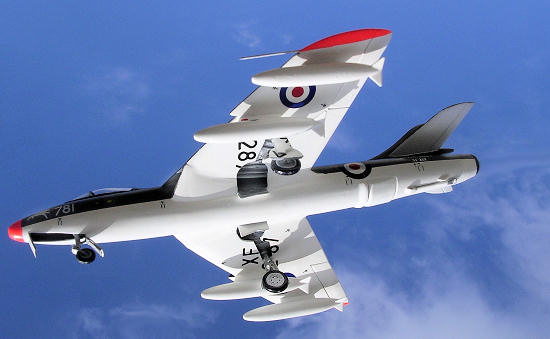
Interior walls and floor of cockpit were matt black. Model decal
sheet No 24 provided decal sheet for the instrument panel. All top surfaces were
airbrushed in dark sea grey while the undersides were semi gloss white. The
markings come from an Allmarks sheet, which also provides colours details by
Richard E Gardner. Fuel tanks added to all four pylons, these were overall white
being navy stock but ones visited Malta had fuel tanks borrowed from RAF stock
and had upper half of tanks paint in dark sea grey. The Allmarks decal sheet
represents an FGA11 XF287: 781 of RNAS Brawdy, lead aircraft of ‘Rough Diamonds’
aerobatic team. A feature with this scheme is that besides the standard FAA
camouflage there is Day Glow Orange spine, nose and wingtips clearly indicated
on the drawing.
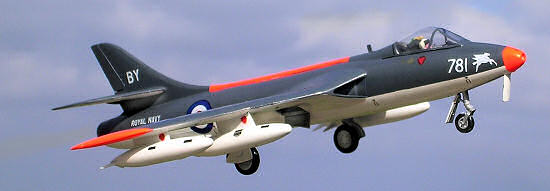 The
Hunter is an aviation legend with many memories of the original issue of the
Airfix kit then bought locally for 2s 6d and were also as common at our
airfields with RAF, and Navy ones on frequent stop over here apart from the many
Air Forces versions which also made a refuelling stop be it Singapore, Iraq,
Kuwait, Saudi Arabia forces to mention just a few. The model this time was a FAA
Hunter, which does not operate from decks of carriers but proved useful to train
crew for the Royal Navy. It suites any collection of FAA aircraft as in fact it
fitted among my Navy types and therefore is recommended for anyone who wants to
have a complete representation of the vast range of Royal Navy operational
aircraft.
The
Hunter is an aviation legend with many memories of the original issue of the
Airfix kit then bought locally for 2s 6d and were also as common at our
airfields with RAF, and Navy ones on frequent stop over here apart from the many
Air Forces versions which also made a refuelling stop be it Singapore, Iraq,
Kuwait, Saudi Arabia forces to mention just a few. The model this time was a FAA
Hunter, which does not operate from decks of carriers but proved useful to train
crew for the Royal Navy. It suites any collection of FAA aircraft as in fact it
fitted among my Navy types and therefore is recommended for anyone who wants to
have a complete representation of the vast range of Royal Navy operational
aircraft.
Carmel J. Attard
March 2012
A brief note: Various references indicate that these
aircraft were called GA.11s in service as they had no guns. Ed
Copyright ModelingMadness.com. All rights reserved. No reproduction in part or in whole without express permission from the editor.
If you would like your product reviewed fairly and fairly quickly , please
contact
the editor or see other details in the
Note to
Contributors.
Back to the Main Page
Back to the Review
Index Page 2023
with
ejector
seat was reshaped, adding seat straps, ejection seat pull handles, control
column and a crew figure painted in the RAF style of costume. A blanking plate
in form of a rectangular plastic card piece was added to avoid the see through
effect across the intakes. Lead weight added to nose and the two fuselage halves
were joined together. Any over scale in thickness at the wing trailing edges was
scraped using one’s own judgement after close study to photos. The cockpit
canopy was not truly accurate and this I replaced with a clear and thinner one
which comes as spare with the Hunter Prototype Pavla set. The kit fuselage tail
pipe was also removed and this was replaced with a spare resin one that comes
also with the Pavla Hunter set referred to earlier. The ammunition link
collectors were removed and the canon ports faired over with filler. An arrestor
hook was added at the rear beneath the fuselage. This was centrally positioned
while a tail bumper was
added adjacent to the hook and to
starboard side.